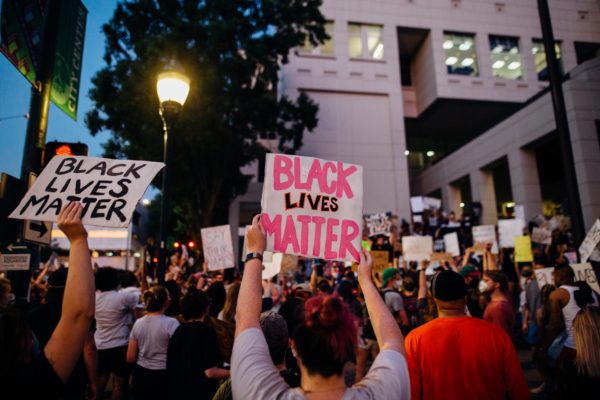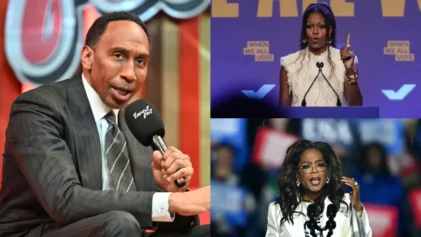Police brutality has been a hot-button issue in the United States for the past decade.
From Trayvon Martin to George Floyd, outrage has roiled over killings of unarmed Black men — particularly at the hands of police. Angry marchers have taken to the streets in cities across the country to condemn law enforcement following police-involved homicides.
The heightened attention triggered a heated national dialogue about police violence, one that took the forefront again last summer in the wake of George Floyd’s death. Many police unions and law enforcement sympathizers routinely rally to the defense of officers and have demonized movement like Black Lives Matter.
But the national movement to reform how police agencies operate has had a more meaningful impact than simply sparking debate, according to a new study.
A researcher found that police killings dropped between 15 percent and 20 percent in places where Black Lives Matter protests occurred between 2014 and 2019.

The report was written by economist Travis Campbell, a fourth-year Ph.D. student at the the University of Massachusetts at Amherst. The Association for Social Economics awarded Campbell the Warren Samuels Prize for his research, which compared deadly use-of-force trends in cities that had BLM protests versus those that didn’t.
“There’s been a lot of people with very strong opinions, often anecdotal, and the opinions are often polarizing, politically,” Campbell told Atlanta Black Star on Thursday. “At the same time, there hasn’t been any real rigorous research to inform opinions beyond just the anecdotes. So I wanted to kind of try and fill that void.”
According to the study, “difference-in-difference estimates” indicated U.S. Census designations that experienced BLM protests in the past five years saw a drawdown in lethal use-of-force and had 300 fewer homicides than those that hadn’t.
Agencies where protests erupted were also more likely to increase their budgets to outfit officers with body cameras and expand community policing, Campbell’s research found.
“The data tells a clear story in that the protests are definitely having a very important and large impact on police lethal use of force specifically,” he said. “But the devil’s in the details of why that’s happening.”
Campbell used data from Fatal Encounters, a nonprofit site that assembled a comprehensive national database of police killings.
In his research, Campbell sought to answer a simple question: Do protests work? He also tried to find a causal effect between BLM protests and subsequent police encounters in the community. He found that police killings dropped 16.8 percent on average after protesters marched through those neighborhoods.
“This fall in lethal use-of-force is growing over time and is prominent when protests are large or frequent,” Campbell wrote. “The results thus far indicate BLM protests reduce lethal use-of-force locally but do not explain why. One way BLM may impact lethal use-of-force is by pressuring local police agencies to change.”
The explanations for why the protests seemed to lead to less police killings are both hopeful and bleak. Campbell cited prior research that strongly suggests bodycams reduce police aggression.
But he also discovered other factors. Arrest numbers fell while non-police homicides rose 10.7 percent in the five years following BLM protests.
One reason for the spike in homicides accompanied by an apparent drop in other crimes, he explained, was that residents lost faith in law enforcement and stopped reporting less serious crimes as much. Campbell found evidence that property crime reports dropped 8.4% after the protests, which meant less police encounters with the community.
“It’s been argued that homicides are the best measure for overall crime because no matter how low police morale or community police trust is, people are going to report homicides and the police are going to follow up on them,” Campbell said.
Campbell also explored a trend known as the “Ferguson Effect.” It’s the belief that police morale drops from the scrutiny and officers grow less enthused to investigate crimes after the protests dissipated in their areas. Campbell’s study lent credence to the theory. He found that police solved 5.2 percent less property crimes even with the reduction in call volume.
Campbell said a combination of more bodycams, citizens relying less on the police, and officers being less vigorous in their approach to investigating crimes may be what caused fatal police shootings to go down.
“It seems like the protests are having a really big impact, and a lot more work needs to be done in understanding why,” he said. “We need to figure out how to keep the best aspects of what the protests are doing but also reduce the costs.
“A reduction in unjustified police killings is definitely a good thing, for a lot of reasons,” Campbell continued. “But the cost can be really high, which the (study) shows. So we want to figure out how we can get the best of both worlds. And in order to do that, we have to be honest about what’s happening.”
On Wednesday, U.S. House members passed the George Floyd Justice in Policing Act, a bill that would create a national registry for police misconduct. It must now go before the Senate before reaching President Joe Biden’s desk.
African Americans died from a cops’ bullets at a higher rate than any other ethnic group over that span. According to online infographics site Statista, 35 Black people per 1 million were gunned down by police compared to 26 per 1 million for Hispanics and 14 per 1 million for white Americans.
Year-by-year numbers are difficult to come by and often give an incomplete glimpse. The FBI began collecting use-of-force information in 2019, but only 42 percent of law enforcement agencies participated in the voluntary reporting system in 2020. There is not currently a reliable government database that accurately tracks police-involved shootings on a national scale.
That has left media outlets like The Washington Post, the L.A. Times and The Guardian to pick up the gauntlet. Websites like Mapping Police Violence have also stepped in to compile unofficial registries of police violence.
According to the Post database, 6,087 people have been shot and killed by law enforcement officers nationwide since Jan. 1, 2015.
In 2015, the U.S. Department of Justice released a report that said more than a quarter of police killings are not accurately reflected on DOJ and Bureau of Justice Statistics databases. The report estimated between 930 and 1,240 Americans are killed by police annually.
“It is unacceptable that The Washington Post and The Guardian newspaper from the U.K. are becoming the lead source of information about violent encounters between police and civilians,” then-FBI Director James Comey said in 2015.


